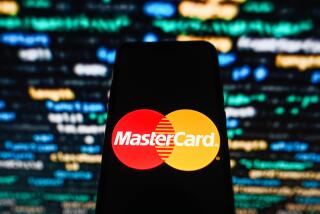Probe of Stealth TV Ads Sought
- Share via
Alarmed by “covert commercial pitches” sneaking into TV news and entertainment shows, Federal Communications Commission member Jonathan S. Adelstein on Wednesday called on the agency to investigate hidden advertising.
Although Adelstein took particular aim at on-air personalities who tout products without divulging that they are paid endorsers, he went an additional step by criticizing the lack of full disclosure in the pay-for-plugs proliferating in scripted and reality TV.
Adelstein lamented the practice, in which advertisers pay to get cars, cellphones, soft drinks and other products prominently featured or mentioned in shows.
“This is becoming so prevalent that people can’t escape it by even taking a bathroom break,” Adelstein said. “It’s OK if the broadcasters do this, but they need to inform the public that it’s being done.”
Failing to disclose payments, he said, violates a 78-year-old FCC rule requiring broadcasters to clearly identify who provided “valuable consideration” to shows. Adelstein also took a swipe at his agency, which is charged with monitoring the public airwaves, for being lax in enforcing the regulations.
Adelstein’s comments mark the strongest words yet from an FCC commissioner about the lack of disclosure in product placement. The Democrat’s remarks came in a speech to the Media Institute in Washington and in a subsequent Times interview. Whether other commissioners would support his call for a crackdown was unclear. Network representatives declined to comment.
Advertisers increasingly count on integrating products into shows to reach viewers using digital video recorders, or DVRs, to skip past their traditional commercial spots. The product placement market is expected to swell to $4.2 billion this year, according to Connecticut-based consulting group PQ Media, up from nearly $3.5 billion last year.
Networks are practically hanging “for sale” signs on their most lucrative programs, so much so that the topic was a running theme last week in New York during the kickoff of the TV industry’s annual sales drive.
Fox Sports announcer Joe Buck joked to advertisers that he would happily hawk their products during Fox baseball broadcasts, just as he did during the 2003 World Series. During Game 1, Buck chatted with Robin Williams, who was in the stadium watching the game. Viewers were informed the comedian was using a cellphone from Sprint, one of the telecast sponsors.
“Think it up,” Buck told advertisers last week. “I’ll try it. I have absolutely no pride.”
At the presentation for the WB -- owned by Time Warner Inc. and Tribune Co., owner of The Times -- actress Amanda Bynes said the characters on her comedy “What I Like About You” were becoming increasingly familiar with real-world products.
“This season we found out, like, they eat Pringles and use Herbal Essence shampoo,” Bynes quipped. “Next season, we hope to find out what cellphones they’re using and what cars they drive.”
But Adelstein bemoaned the practice as part of the “bottomless pit of commercialism in today’s media.” He said that when viewers were left uninformed it amounted to illegal payola.
“Everything from Coke to soap is subliminally hawked in TV programs,” Adelstein said. “In today’s media environment, product placement has moved beyond Coke tumblers prominently displayed at the judges’ table of ‘American Idol.’ Now, products have even seeped into plot lines.”
These days advertisers pay as much as $2 million an episode to get their products featured on NBC’s “The Apprentice.”
Adelstein said networks needed to go further than inserting a fleeting mention of a paid sponsorship in a show’s closing credits, which is how the practice is often handled. On Fox’s “American Idol,” for example, the closing credits quickly note that Coca-Cola, Ford and Cingular Wireless are paid sponsors.
“A disclosure that appears on screen for a split second during the credits in small type that no one could possibly read without pausing their DVR -- and pulling out a magnifying glass -- could not possibly qualify,” he said.
Gary Ruskin, executive director of the nonprofit Commercial Alert, applauded Adelstein’s remarks. His group filed a complaint in 2003 about product placement that the FCC has yet to rule on. Commercial Alert asked that payment disclosures come at the beginning of a show and on screen when an embedded image appears.
“The whole television industry has moved to stealth advertising,” Ruskin said. “It’s dishonest advertising that sneaks by our critical faculties and plants messages in our brains when we are paying less attention.”
*
(BEGIN TEXT OF INFOBOX)
Featured goods
Here are some recent examples of brand-name products being integrated into television shows.
* Teams competing on NBC’s “The Apprentice” were required to design a bottle and marketing campaign for Pepsi-Cola North America’s new soft drink Pepsi Edge.
* On Fox’s “The O.C.,” a couple planning a vacation looked up their mileage on AmericanAirlines.com.
* One of the main characters on ABC’s “Desperate Housewives” accepted a job at a mall as the spokesmodel for the Buick LaCrosse.
* An episode of the WB’s “What I Like About You” revolved around two characters entering a contest to become the new Clairol Herbal Essences Girl.
* On CBS’ “Survivor: Palau,” tribes used Home Depot tools to construct bathrooms.
Sources: Times research, IAG Research
More to Read
The biggest entertainment stories
Get our big stories about Hollywood, film, television, music, arts, culture and more right in your inbox as soon as they publish.
You may occasionally receive promotional content from the Los Angeles Times.











